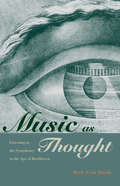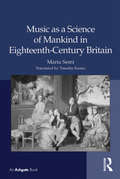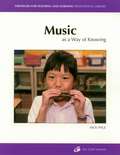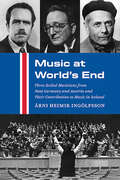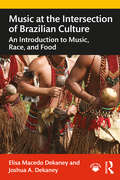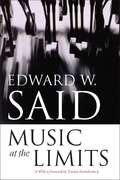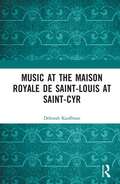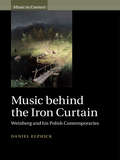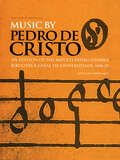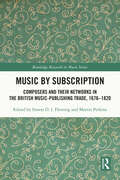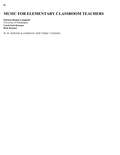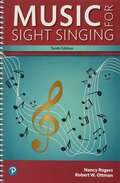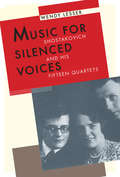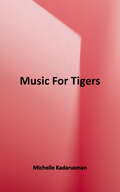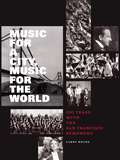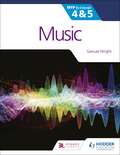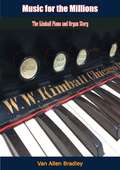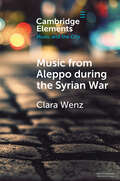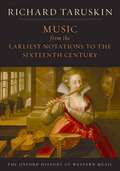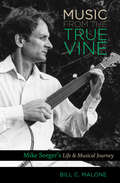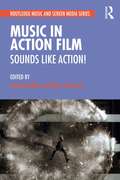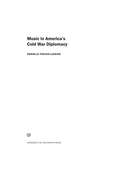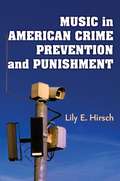- Table View
- List View
Music as Thought: Listening to the Symphony in the Age of Beethoven
by Mark Evan BondsBefore the nineteenth century, instrumental music was considered inferior to vocal music. Kant described wordless music as "more pleasure than culture," and Rousseau dismissed it for its inability to convey concepts. But by the early 1800s, a dramatic shift was under way. Purely instrumental music was now being hailed as a means to knowledge and embraced precisely because of its independence from the limits of language. What had once been perceived as entertainment was heard increasingly as a vehicle of thought. Listening had become a way of knowing. Music as Thought traces the roots of this fundamental shift in attitudes toward listening in the late eighteenth and early nineteenth centuries. Focusing on responses to the symphony in the age of Beethoven, Mark Evan Bonds draws on contemporary accounts and a range of sources--philosophical, literary, political, and musical--to reveal how this music was experienced by those who heard it first. Music as Thought is a fascinating reinterpretation of the causes and effects of a revolution in listening.
Music as a Science of Mankind in Eighteenth-Century Britain
by Maria Semi translated by KeatesMusic as a Science of Mankind offers a philosophical and historical perspective on the intellectual representation of music in British eighteenth-century culture. From the field of natural philosophy, involving the science of sounds and acoustics, to the realm of imagination, involving resounding music and art, the branches of modern culture that were involved in the intellectual tradition of the science of music proved to be variously appealing to men of letters. Among these, a particularly rich field of investigation was the British philosophy of the mind and of human understanding, developed between the seventeenth and eighteenth centuries, which looked at music and found in its realm a way of understanding human experience. Focussing on the world of sensation - trying to describe how the human mind could develop ideas and emotions by its means - philosophers and physicians often took their cases from art's products, be it music (sounds), painting (colours) or poetry (words as signs of sound conveying a meaning), thus looking at art from a particular point of view: that of the perceiving mind. The relationship between music and the philosophies of mind is presented here as a significant part of the construction of a Science of Man: a huge and impressive 'project' involving both the study of man's nature, to which - in David Hume's words - 'all sciences have a relation', and the creation of an ideal of what Man should be. Maria Semi sheds light on how these reflections moved towards a Science of Music: a complex and articulated vision of the discipline that was later to be known as 'musicology'; or Musikwissenschaft.
Music as a Way of Knowing
by Nick PageNick Page loves to make and share music with his students, and it's likely that you will too by the time you've finished his passionate, thought-provoking book. You will also have developed a new understanding of and appreciation for the role music can play in supporting learners. A music educator and song leader who has devoted his professional life to helping people of all ages realize that they are "capable of great miracles through the simple, yet powerful, act of singing," Nick is particularly devoted to multicultural music and works diligently to promote music of diverse cultures. Rich with ideas on how to use music in the classroom, Music as a Way of Knowing will appeal especially to classroom teachers who are not musicians, but who enjoy and learn from music and want to use it with their students. Indeed, Nick reveals the truth of the Zimbabwean adage: "If you can talk, you can sing. If you can walk, you can dance. " Nick provides simple instructions for writing songs, using music to support learning across the curriculum, teaching singing effectively, and finding good songs. He assures you that with time, all students can sing well. The good news is that once you've read this book, you'll have the confidence to trust yourself-and your students-to sing and learn well through the joy and power of music.
Music at World's End: Three Exiled Musicians from Nazi Germany and Austria and Their Contribution to Music in Iceland
by Árni Heimir IngólfssonIn Iceland in the 1930s, classical music was only beginning to be seriously practiced, at the same time when musicians of Jewish heritage were fleeing Nazi Germany and Austria. Despite the country’s strict immigration policy, three outstanding young musicians were allowed to settle there: Robert Abraham, Heinz Edelstein, and Victor Urbancic. Their influence on Iceland’s music scene as conductors, instrumentalists, teachers, and scholars proved invaluable. In Music at World's End, the first in-depth study of the lives and careers of these three musicians, musicologist Árni Ingólfsson examines their formative years in Germany and Austria, their dramatic escapes from the Nazi regime, and their triumphs and frustrating setbacks in their new homeland, a country in which Jews were virtually unknown. This fascinating case study is a valuable addition to studies of musical exile during World War II and beyond.
Music at the Intersection of Brazilian Culture: An Introduction to Music, Race, and Food
by Elisa Macedo Dekaney Joshua A. DekaneyMusic at the Intersection of Brazilian Culture takes an interdisciplinary approach by utilizing several aspects of Brazilian music, race, and food as a window to understanding Brazilian culture, with music at the core. Through a holistic understanding of the Brazilian experience – exploring issues of race, colonization, sustainable development, and the contributions of the three distinct ethnic groups in the making of Brazil – the authors create a narrative based on their own recollection of memories, traditions, customs, sounds, and landscapes that they experienced in Brazil. Each engaging section begins with an overview of the topic that places it in historical context, and then focuses on each subtopic with a thorough presentation of the content as well as suggested activities that can be implemented in the classroom. The chapters conclude with a list of useful references, resources, and audio recording examples, which are available on Spotify, to present readers with a musical landscape of the folktales. These can be found online via the Routledge catalogue page for this book. This book is an essential resource for students and teachers of music and cultural studies, as it unpicks complex issues to help readers better understand and appreciate Brazilian culture.
Music at the Limits: Three Decades Of Essays And Articles On Music
by Edward SaidMusic at the Limits is the first book to bring together three decades of Edward W. Said's essays and articles on music. Addressing the work of a variety of composers, musicians, and performers, Said carefully draws out music's social, political, and cultural contexts and, as a classically trained pianist, provides rich and often surprising assessments of classical music and opera.Music at the Limits offers both a fresh perspective on canonical pieces and a celebration of neglected works by contemporary composers. Said faults the Metropolitan Opera in New York for being too conservative and laments the way in which opera superstars like Pavarotti have "reduced opera performance to a minimum of intelligence and a maximum of overproduced noise." He also reflects on the censorship of Wagner in Israel; the worrisome trend of proliferating music festivals; an opera based on the life of Malcolm X; the relationship between music and feminism; the pianist Glenn Gould; and the works of Mozart, Bach, Richard Strauss, and others. Said wrote his incisive critiques as both an insider and an authority. He saw music as a reflection of his ideas on literature and history and paid close attention to its composition and creative possibilities. Eloquent and surprising, Music at the Limits preserves an important dimension of Said's brilliant intellectual work and cements his reputation as one of the most influential and groundbreaking scholars of the twentieth century.
Music at the Maison royale de Saint-Louis at Saint-Cyr
by Deborah KauffmanThe history of music at the Maison royale de Saint-Louis at Saint-Cyr — the famous convent school founded by Madame de Maintenon and established by Louis XIV in 1686 as a royal foundation — is both rich and intriguing; its large repertory of music was composed expressly for young female voices by important composers working within significant contemporary musical genres: liturgical chant, sacred motets, theatrical music, and cantiques spirituels. While these genres reflect contemporary styles and trends, at the same time the works themselves were made to conform to the sensibilities and abilities of their intended performers. Even as Jean-Baptiste Moreau's music for Jean Racine’s biblical tragedies Esther and Athalie shows a number of similarities to contemporary tragédies lyriques, it departs from that more public genre in its brevity, generally simpler solo writing, and the integral use of the chorus. The musical style of the choral numbers closely parallels that of other choral music in the repertory at Saint-Cyr. The liturgical chant sung in the church was composed by Guillaume-Gabriel Nivers, and is an example of plain-chant musical, a type of new ecclesiastical composition written during the seventeenth and eighteenth centuries, primarily for female religious communities in France. The large repertory of petits motets (short sacred Latin pieces for solo voice), mostly composed by Nivers and Louis-Nicolas Clérambault, are simpler and more restrained than works by their contemporaries. A close study of the motets reveals much about changes to musical style and performance practices at Saint-Cyr during the eighteenth century. The cantique spirituel, a song with a spiritual text in the vernacular French language, played a significant role in both the education and recreation of the girls at Saint-Cyr. Cantiques composed for the girls vary widely in terms of their style and difficulty, ranging from simple strophic melodies to more sophisticated works in the style of contemporary airs. In all cases, the stylistic features of the music for Saint-Cyr reflect a careful consideration of the needs and capabilities of the young singers of the school, as well as an awareness of the rigorous requirements of Madame de Maintenon, who kept a close watch over the propriety of all things relating to the piety, behavior, and image of her charges.
Music behind the Iron Curtain: Weinberg and his Polish Contemporaries (Music in Context)
by Daniel ElphickMieczysław Weinberg left his family behind and fled his native Poland in September 1939. He reached the Soviet Union, where he become one of the most celebrated composers. He counted Shostakovich among his close friends and produced a prolific output of works. Yet he remained mindful of the nation that he had left. This book examines how Weinberg's works written in Soviet Russia compare with those of his Polish contemporaries; how one composer split from his national tradition and how he created a style that embraced the music of a new homeland, while those composers in his native land surged ahead in a more experimental vein. The points of contact between them are enlightening for both sides. This study provides an overview of Weinberg's music through his string quartets, analysing them alongside Polish composers. Composers featured include Bacewicz, Meyer, Lutosławski, Panufnik, Penderecki, Górecki, and a younger generation, including Szymański and Knapik.
Music by Pedro de Cristo (Music Archive Publications #Vol. 1)
by Owen ReesFirst Published in 1999. Routledge is an imprint of Taylor & Francis, an informa company.
Music by Subscription: Composers and their Networks in the British Music-Publishing Trade, 1676–1820 (Routledge Research in Music)
by Simon D. I. Fleming Martin PerkinsThis book breaks new ground in the social and cultural history of eighteenth-century music in Britain through the study of a hitherto neglected resource, the lists of subscribers that were attached to a wide variety of publications, including musical works. These lists shed considerable light on the nature of those who subscribed to music, including their social status, place of employment, residence, and musical interests. Through broad analysis of subscription data, the contributors reveal insights into social and economic changes during the period, and the types of music favoured by groups like music clubs, the aristocracy, the clergy, and by men and women. With chapters on female composers and listeners, music and the slave economy, musical patronage, the print trade, and nationality, this book provides innovative perspectives that enhance our understanding of music’s social spheres, the emergence of music publishing, and the potential of digital musicology research.
Music for Elementary Classroom Teachers
by Patricia Shehan Campbell Carol Scott-Kassner Kirk KassnerLearn how to use the power of music to enhance other subjects. Written for both elementary education majors and K-6 classroom teachers, the text is rooted in cognitive research on children’s development. <p><p>The book offers myriad instructional plans that weave songs, dances, and carefully constructed listening experiences into subjects ranging from language arts and social studies to mathematics, science, and the arts. It also provides opportunities for engaging children in expressive-creative practices.
Music for Sight Singing
by Nancy Rogers Robert OttmanFor courses in sight singing and music theory. The most celebrated, engaging, and musical sight-singing text on the market A freshly updated edition of the classic musical textbook, Music for Sight Singing, 10th Edition, is structured around organized melodies, drawn from the literature of composed music and a wide range of the world’s folk music. Real music exercises allow readers to practice sight singing and develop their “mind’s ear,” the ability to imagine how music sounds without first playing it on an instrument. The new edition includes even more melodies and several new topics; improved introductions to minor keys, pre-dominant leaps, and chromaticism; and increased use of bass and C clefs ― while retaining the simple-to-complex arrangement that lays the foundation for success.
Music for Silenced Voices: Shostakovich and His Fifteen Quartets
by Wendy LesserMost previous books about Dmitri Shostakovich have focused on either his symphonies and operas, or his relationship to the regime under which he lived, or both, since these large-scale works were the ones that attracted the interest and sometimes the condemnation of the Soviet authorities. Music for Silenced Voiceslooks at Shostakovich through the back door, as it were, of his fifteen quartets, the works which his widow characterized as a "diary, the story of his soul. " The silences and the voices were of many kinds, including the political silencing of adventurous writers, artists, and musicians during the Stalin era; the lost voices of Shostakovich's operas (a form he abandoned just before turning to string quartets); and the death-silenced voices of his close friends, to whom he dedicated many of these chamber works. Wendy Lesser has constructed a fascinating narrative in which the fifteen quartets, considered one at a time in chronological order, lead the reader through the personal, political, and professional events that shaped Shostakovich's singular, emblematic twentieth-century life. Weaving together interviews with the composer's friends, family, and colleagues, as well as conversations with present-day musicians who have played the quartets, Lesser sheds new light on the man and the musician. One of the very few books about Shostakovich that is aimed at a general rather than an academic audience,Music for Silenced Voicesis a pleasure to read; at the same time, it is rigorously faithful to the known facts in this notoriously complicated life. It will fill readers with the desire to hear the quartets, which are among the most compelling and emotionally powerful monuments of the past century's music.
Music for Tigers
by Michelle Kadarusman“Middle-school student Louisa wants to spend the summer practicing violin for a place in the youth symphony, but is instead sent to the Tasmanian rain forest camp of her Australian relatives. There she learns that her family secretly protects the last of the supposedly extinct Tasmanian tigers. When an encroaching mining operation threatens the hidden sanctuary, Louisa realizes her music can help” - Provided by publisher.
Music for a City Music for the World
by Larry RotheIn Music for a City, Music for the World, Larry Rothe shares how the San Francisco Bay Area's love of music, rooted in the Gold Rush, gave birth to a Grammy-winning and internationally acclaimed orchestra. Released in time for the San Francisco Symphony's celebration of its 100th anniversary, this definitive history replete with hundreds of archival photos and images gives readers a behind-the-scenes glimpse into one of the world's foremost orchestras and, in so doing, illuminates the cultural life of a city.
Music for the IB MYP 4&5: MYP by Concept
by Samuel WrightA concept-driven and assessment -focused approach to Music teaching and learning.- Approaches each chapter with statements of inquiry framed by key and related concepts, set in a global context.- Supports every aspect of assessment using tasks designed by an experienced MYP educator.- Differentiates and extends learning with research projects and interdisciplinary opportunities.- Applies global contexts in meaningful ways to offer an MYP Music programme with an internationally-minded perspective.Also available Student eTextbook 9781510475533Whiteboard eTextbook 9781510475540Teacher's Pack 9781510478145
Music for the IB MYP 4&5: MYP by Concept
by Samuel WrightA concept-driven and assessment -focused approach to Music teaching and learning.- Approaches each chapter with statements of inquiry framed by key and related concepts, set in a global context.- Supports every aspect of assessment using tasks designed by an experienced MYP educator.- Differentiates and extends learning with research projects and interdisciplinary opportunities.- Applies global contexts in meaningful ways to offer an MYP Music programme with an internationally-minded perspective.Also available Student eTextbook 9781510475533Whiteboard eTextbook 9781510475540Teacher's Pack 9781510478145
Music for the Millions: The Kimball Piano and Organ Story
by Van Allen BradleyIn Music for the Millions, author Van Allen Bradley tells the story of a firm which, at the time of this book’s original publication in 1962, had endured for 100 years.But the Kimball Piano and Organ Company accomplished more than simply surviving a century—it played a dominant role in the development of the industry of which it was a part.The company started as a piano dealership in Chicago in 1857 as W.W. Kimball and Company by William Wallace Kimball (1828-1904). In 1864, Kimball moved from its earliest location in the corner of a jewelry store to sales rooms in the Crosby Opera House. The Great Chicago Fire destroyed all of Kimball’s commercial assets in 1871, but he continued selling from his home, and rebuilt his dealership business.In 1877, W.W. Kimball began assembling its own reed organs, and after three years the company began offering organs made entirely in-house. In 1882, the Kimball company was incorporated, and an expansive factory was built to produce reed organs; soon, the factory was producing 15,000 organs a year—the world’s largest organ maker.In 1887, Kimball began building a five-story factory for making its own pianos, and the next year produced 500 instruments of indifferent quality. By 1893 at the World’s Columbian Exposition, at which Kimball received the “Worlds Columbian Exposition Award,” Kimball was known for high quality, efficiency in manufacture, and aggressive sales practices, using 35-40 traveling salesmen to cover cities and remote areas.In 1959, the W.W. Kimball Company was purchased from the last remaining Kimball family heir by Mr. Arnold F. Habig and became a wholly owned subsidiary of The Jasper Corporation. Piano production was relocated to the small, southern Indiana town of West Baden, Indiana, where the company was rejuvenated and once again began to grow—10 years after the purchase, Kimball was once again the world’s largest piano company.
Music from Aleppo during the Syrian War: Displacement and Memory in Hello Psychaleppo's Electro-Tarab (Elements in Music and the City)
by Clara WenzAleppo is regarded as one of the historical centres of an urban Arab art music tradition known as 'tarab'. During the war that followed Syria's 2011 political uprisings, vast parts of the city were destroyed. This Element explores how 'tarab' lives on in new contexts. It does so through a focus on the work of Hello Psychaleppo, one of Aleppo's displaced musicians and the pioneer of 'electro-tarab', an eclectic style of urban electronic dance music that is conceived as a homage to Aleppo's musical legacy. Whether local religious chants, Palestinian poetry, or the image of a yellow man, electro-tarab includes an inventory of audio, visual and literary samples. These samples help conceptualise the role music has played during the Syrian war; they offer insights into Aleppo's musical and diasporic afterlife; and they illuminate some of the socio-aesthetic parameters that characterise contemporary Arab electronic music.
Music from a Landfill (Fountas & Pinnell Classroom, Guided Reading Grade 3)
by Laura JohnsonNIMAC-sourced textbook
Music from the Earliest Notations to the Sixteenth Century: The Oxford History of Western Music
by Richard TaruskinThe universally acclaimed and award-winning Oxford History of Western Music is the eminent musicologist Richard Taruskin's provocative, erudite telling of the story of Western music from its earliest days to the present. Each book in this superlative five-volume set illuminates-through a representative sampling of masterworks- the themes, styles, and currents that give shape and direction to a significant period in the history of Western music. <p><p>This first volume in Richard Taruskin's majestic history, Music from the Earliest Notations to the Sixteenth Century , sweeps across centuries of musical innovation to shed light on the early forces that shaped the development of the Western classical tradition. Beginning with the invention of musical notation more than a thousand years ago, Taruskin addresses topics such as the legend of Saint Gregory and Gregorian chant, Augustine's and Boethius's thoughts on music, the liturgical dramas of Hildegard of Bingen, the growth of the music printing business, the literary revolution and the English madrigal, the influence of the Reformation and the Counter-Reformation, and the operas of Monteverdi. Laced with brilliant observations, memorable musical analysis, and a panoramic sense of the interactions between history, culture, politics, art, literature, religion, and music, this book will be essential reading for anyone who wishes to understand this rich and diverse period.
Music from the True Vine: Mike Seeger's Life and Musical Journey
by Bill C. MaloneA musician, documentarian, scholar, and one of the founding members of the influential folk revival group New Lost City Ramblers, Mike Seeger (1933-2009) spent more than fifty years collecting, performing, and commemorating the culture and folk music of white and black southerners, which he called "music from the true vine. " In this fascinating biography, Bill Malone explores the life and musical contributions of folk artist Seeger, son of musicologists Charles and Ruth Crawford Seeger and brother of folksingers Pete and Peggy Seeger. Malone argues that Seeger, while not as well known as his brother, may be more important to the history of American music through his work in identifying and giving voice to the people from whom the folk revival borrowed its songs. Seeger recorded and produced over forty albums, including the work of artists such as Libba Cotton, Tommy Jarrell, Dock Boggs, and Maybelle Carter. In 1958, with an ambition to recreate the southern string bands of the twenties, he formed the New Lost City Ramblers, helping to inspire the urban folk revival of the sixties. Music from the True Vinepresents Seeger as a gatekeeper of American roots music and culture, showing why generations of musicians and fans of traditional music regard him as a mentor and an inspiration.
Music in Action Film: Sounds Like Action!
by James Buhler Mark DurrandMusic in Action Film is the first volume to address the central role of music and sound in action film—arguably the most dominant form of commercial cinema today. Bringing together 15 essays by established and emerging scholars, the book encompasses both Hollywood blockbusters and international films, from classic works such as The Seven Samurai to contemporary superhero franchises. The contributors consider action both as genre and as a mode of cinematic expression, in chapters on evolving musical conventions; politics, representation, and identity; musical affect and agency; the functional role of music and sound design in action film; and production technologies. Breaking new critical ground yet highly accessible, this book will be of interest to students and scholars of music and film studies.
Music in America's Cold War Diplomacy
by Danielle Fosler-LussierDuring the Cold War, thousands of musicians from the United States traveled the world, sponsored by the U.S. State Department's Cultural Presentations program. Performances of music in many styles--classical, rock 'n' roll, folk, blues, and jazz--competed with those by traveling Soviet and mainland Chinese artists, enhancing the prestige of American culture. These concerts offered audiences around the world evidence of America's improving race relations, excellent musicianship, and generosity toward other peoples. Through personal contacts and the media, musical diplomacy also created subtle musical, social, and political relationships on a global scale. Although born of state-sponsored tours often conceived as propaganda ventures, these relationships were in themselves great diplomatic achievements and constituted the essence of America's soft power. Using archival documents and newly collected oral histories, Danielle Fosler-Lussier shows that musical diplomacy had vastly different meanings for its various participants, including government officials, musicians, concert promoters, and audiences. Through the stories of musicians from Louis Armstrong and Marian Anderson to orchestras and college choirs, Fosler-Lussier deftly explores the value and consequences of "musical diplomacy."
Music in American Crime Prevention and Punishment
by Hirsch Lily E.Although the use of music for extramusical purposes has been a part of American culture for some time, the phenomenon remained largely unknown to the general public until revelations became widespread of startling military practices during the second Iraq War. In Music in American Crime Prevention and Punishment, Lily E. Hirsch explores the related terrain at the intersection of music and law, demonstrating the ways in which music has become a tool of law enforcement and justice through: police and community leaders’ use of classical music in crime deterrence and punishment; the use of rap lyrics as prosecutorial evidence; allegations of music as incitement to violence; and the role of music in U. S. prisons and in detention centers in Guantanamo, Iraq, and Afghanistan. In the course of her study, Hirsch asks several questions: How does the law treat music? When and why does music participate in the law? How does music influence the legal process? How does the legal process influence music? And how do these appropriations affect the Romantic ideals underlying our view of music?
